Equipment to Capture Bacteria at Altitudes of 36,000 Meters
A student project, led by University of Houston physics major Samuel Morelos and advised by Andrew Renshaw, assistant professor of physics, was selected for this year’s High Altitude Student Platform (HASP) project.
 High-Altitude Student Platform team, from left to right: Fre’Etta Brooks, Steven Oliver, Alejandra Cruz, Diego Hernandez, Samuel Morelos, Dorian Dela Peña and Andrew Renshaw. Not pictured: Debora Mroczek, Jaelyn Kelly and Jaime Juarez.HASP, an annual upper atmosphere balloon mission supported by the NASA Balloon Program Office and the Louisiana Space Consortium, offers student teams from around the country the opportunity to fly a payload of their own design. The UH project was one of 12 selected for this year’s flight.
High-Altitude Student Platform team, from left to right: Fre’Etta Brooks, Steven Oliver, Alejandra Cruz, Diego Hernandez, Samuel Morelos, Dorian Dela Peña and Andrew Renshaw. Not pictured: Debora Mroczek, Jaelyn Kelly and Jaime Juarez.HASP, an annual upper atmosphere balloon mission supported by the NASA Balloon Program Office and the Louisiana Space Consortium, offers student teams from around the country the opportunity to fly a payload of their own design. The UH project was one of 12 selected for this year’s flight.
“For this project, we want to capture bacteria at high altitudes,” Morelos said. To do that, their team designed equipment to selectively capture bacteria at altitudes of 36,000 meters, which is just a little more than 22 miles above sea level. Team members include physics majors Fre’Etta Brooks, Jaelyn Kelly, Debora Mroczek, Steven Oliver, Dorian Dela Peña, as well as engineering majors Alejandra Cruz, Diego Hernandez and Jaime Juarez.
“They designed a payload to collect extremophiles, which are microbes and bacteria that survive in extreme conditions, from the upper atmosphere and return them safely and uncontaminated back to Earth for study in the lab,” said Renshaw, who joined the College of Natural Sciences and Mathematics faculty in 2015.
In addition to capturing bacteria in the upper atmosphere, this payload contains environment sensors and cosmic radiation detectors to collect data throughout the mission, in order to provide insight into the living environment of these extremophiles.
The initial design for this equipment was developed over the summer, with support from the Summer Undergraduate Research Fellowship, a 10-week program that offers undergraduates the chance to engage in independent research projects under the guidance of a UH faculty member.
“Here at UH, we have an exceptional group of undergraduate students,” Renshaw said. “These students have shown a real enthusiasm for learning the necessary skills to design this payload.”
The payload will need to be built, tested and shipped by July 31, with the flight scheduled for this fall in Fort Sumner, New Mexico. The flight will last 15-20 hours and reach an altitude of 36,000 meters.
- Rachel Fairbank, College of Natural Sciences and Mathematics